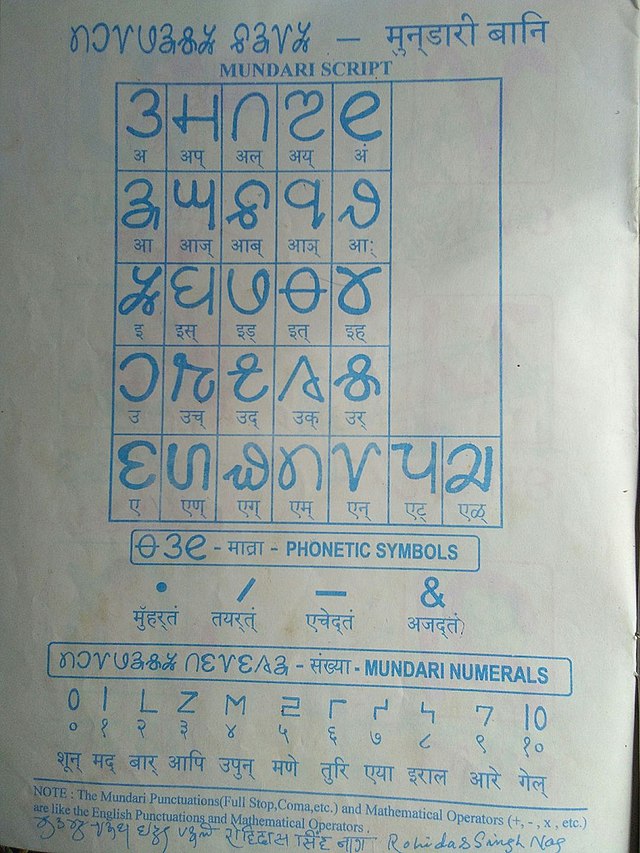Top Qs
Timeline
Chat
Perspective
Mundari language
Munda language spoken in eastern India From Wikipedia, the free encyclopedia
Remove ads
Mundari is a Munda language of the Austroasiatic language family spoken by the Munda tribes in eastern Indian states of Jharkhand, Odisha and West Bengal and northern Rangpur Division of Bangladesh.[3] It is closely related to Ho and Santali.[4] Mundari Bani, a script specifically to write Mundari, was invented by Rohidas Singh Nag.[5][6] It has also been written in the Devanagari, Odia, Bengali, and Latin writing systems.
Remove ads
History
According to linguist Paul Sidwell (2018), Munda languages probably arrived on coast of Odisha from Indochina about 4000–3500 years ago and spread after Indo-Aryan migration to Odisha.[7]
Geographical distribution
Distribution of Mundari language (incl. Munda) in the state of India (2011)[1]
- Jharkhand (57.6%)
- Odisha (29.5%)
- Assam (5.70%)
- West Bengal (4.73%)
- Other (2.49%)
Mundari is spoken in the Khunti, Ranchi, Seraikela Kharsawan and West Singhbhum, East Singhbhum district of Jharkhand, and in the Mayurbhanj, Kendujhar, Sundargarh district of Odisha by at least 1.1 million people.[9] Another 500,000, mainly in Odisha and Assam, are recorded in the census as speaking "Munda," potentially another name for Mundari.
Remove ads
Dialects
Toshiki Osada (2008:99), citing the Encyclopaedia Mundarica (vol. 1, p. 6), lists the following dialects of Mundari, which are spoken mostly in Jharkhand state.
- Hasada ([hasa-daʔ]): east of the Ranchi-Chaibasa Road
- Naguri ([naɡuri]): west of the Ranchi-Chaibasa Road
- Tamaria ([tamaɽ-ia]) or Latar: Panchpargana area (Tamar, Bundu, Rahe, Sonahatu, Silli)
- Kera ([keraʔ]): ethnic Oraon who live in the Ranchi city area
Phonology
Summarize
Perspective
The phonology of Mundari is similar to the surrounding closely related Austroasiatic languages but considerably different from either Indo-Aryan or Dravidian. Perhaps the most foreign phonological influence has been on the vowels. Whereas the branches of Austroasiatic in Southeast Asia are rich in vowel phonemes, Mundari has only five. The consonant inventory of Mundari is similar to other Austroasiatic languages with the exception of retroflex consonants, which seem to appear only in loanwords. (Osada 2008)
Vowels
Mundari has five vowel phonemes. All vowels have long and short as well as nasalized allophones, but neither length nor nasality are contrastive. All vowels in open monosyllables are quantitatively longer than those in closed syllables, and those following nasal consonants or /ɟ/ are nasalized. Vowels preceding or following /ɳ/ are also nasalized.
Consonants
Mundari's consonant inventory consists of 23 basic phonemes. The Naguri and Kera dialects include aspirated stops as additional phonemes, here enclosed in parentheses.
Remove ads
Counting
Remove ads
Relations
Verb
Remove ads
Writing system

Mandari is also written in native Mundari Bani, invented in the 1980s by Rohidas Singh Nag.
Grammar
It has been claimed the Mundari has no word classes, so that nouns, verbs, and adjectives are distinguished only by context. However, this has been disputed, notably by Evans and Osada in 2005.[10]
Notes
References
Sources
Further reading
External links
Wikiwand - on
Seamless Wikipedia browsing. On steroids.
Remove ads